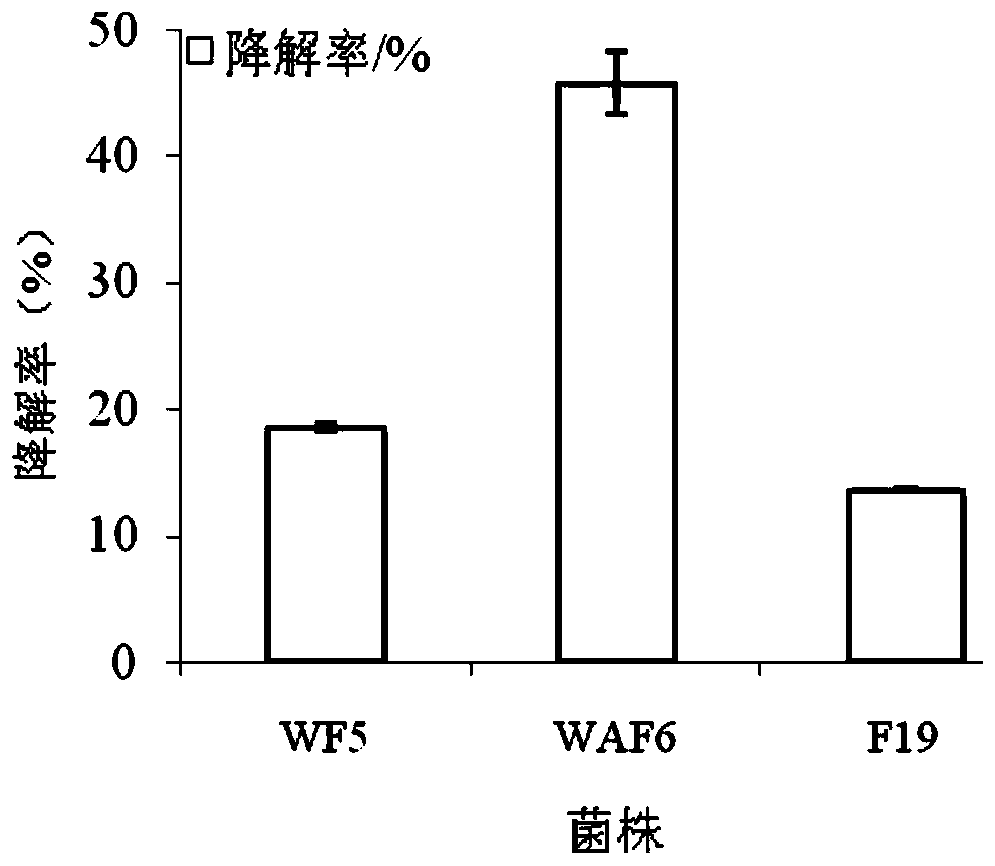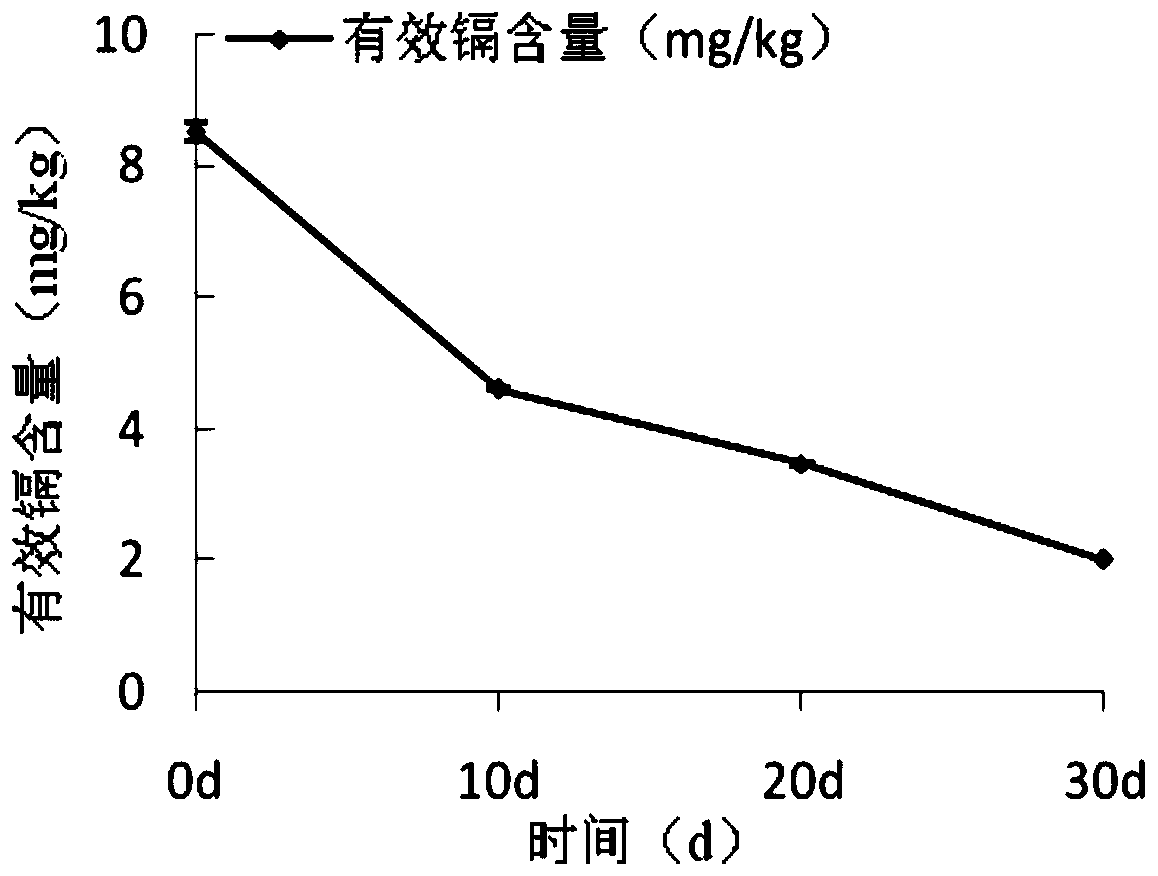Penicillium oxalicum strain capable of degrading cellulose and adsorbing cadmium and application thereof
A technology for Penicillium oxalate and cellulose degradation, which is applied in the field of environmental management, can solve problems such as reducing the effectiveness of lead, and achieve the effects of reducing bioavailability, repairing heavy metal pollution in soil, and improving colonization ability.
- Summary
- Abstract
- Description
- Claims
- Application Information
AI Technical Summary
Problems solved by technology
Method used
Image
Examples
Embodiment 1
[0028] Embodiment 1: the culture medium that invention uses
[0029] (1) Separation medium: CMC medium: sodium carboxymethylcellulose (CMC-Na) 10.0g, KH2PO4 0.25g, potato juice 100mL, agar powder 18.0g, distilled water 1000mL.
[0030] (2) Purification and storage medium: PDA medium: 200 g of potatoes, 20.0 g of glucose, 18.0 g of agar powder, and 1000 mL of distilled water.
[0031] (3) Cadmium ion-containing medium: 200g of potatoes, 20.0g of glucose, 18.0g of agar powder, and 1000mL of distilled water. Add cadmium ion-containing mother liquor (20mg / mL) as needed to prepare solid medium with different concentrations of cadmium ions.
[0032] (4) Screening medium:
[0033] a. Congo red medium: CMC-Na 2.0g, KH 2 PO 4 0.5g, MgSO 4 ·7H 2 O 0.25g, (NH 4 ) 2 SO 4 1.0g, Congo red 0.1g, agar powder 18.0g, distilled water 1000mL;
[0034] b. Re-screening medium: CMC-Na 5.0g, KH 2 PO 4 1.0g, MgSO 4 ·7H 2 O 0.5g, NaNO 3 3.0g, KCl0.5g, FeCl 3 ·6H 2 O 0.01g, distilled w...
Embodiment 2
[0036] Embodiment 2: Separation and purification of bacterial strain
[0037] The specific method for the isolation and purification of the bacterial strain is: using the dilution plate coating method, the soil sample is prepared by gradient dilution with sterile water for 10 -3 -10 -5 Bacteria suspension, and spread on the separation medium, and cultured in a constant temperature incubator at 28°C for 2-3 days, the isolated fungi were streaked, purified and preserved in PDA medium, and the purified strains were Store in a refrigerator at 4°C.
[0038] The classification of the Penicillium oxalicum strain is named Penicillium oxalicum (Penicillium oxalicum) WAF6, and its preservation number is ACCC 32731, and its biological characteristics are: the edge of the colony is white and velvety; the surface is covered with dark green spores, and the spores are easy to fall off; The optimum culture pH is 6.5, and the optimum culture temperature is 28°C; spores can be produced after ...
Embodiment 3
[0039] Example 3: Evaluation of cadmium ion tolerance of bacterial strain WAF6
[0040] The cadmium ion tolerance evaluation method of bacterial strain WAF6 of the present invention specifically comprises the following steps:
[0041] (1) Prepare PDA medium containing different cadmium ion concentrations, the concentration is set to 0, 10, 50, 80, 100, 150, 200 mg / L;
[0042] (2) Use a 5mm hole puncher to make bacterial cakes from the bacterial strain, inoculate it on the plate medium described in step (1) under aseptic conditions, and cultivate it in a constant temperature incubator at 26-28°C for 3-5 days to observe the growth of the bacterial strain. growing situation.
[0043] Strain WAF6 grows well on a plate with a cadmium ion concentration of 0-150mg / L, but growth is completely inhibited on a plate with a cadmium ion concentration of 200mg / L, so the cadmium ion concentration tolerance range of this strain is 0-150mg / L.
PUM
 Login to View More
Login to View More Abstract
Description
Claims
Application Information
 Login to View More
Login to View More - R&D
- Intellectual Property
- Life Sciences
- Materials
- Tech Scout
- Unparalleled Data Quality
- Higher Quality Content
- 60% Fewer Hallucinations
Browse by: Latest US Patents, China's latest patents, Technical Efficacy Thesaurus, Application Domain, Technology Topic, Popular Technical Reports.
© 2025 PatSnap. All rights reserved.Legal|Privacy policy|Modern Slavery Act Transparency Statement|Sitemap|About US| Contact US: help@patsnap.com



